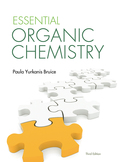
EBK ESSENTIAL ORGANIC CHEMISTRY
3rd Edition
ISBN: 8220100659461
Author: Bruice
Publisher: PEARSON
expand_more
expand_more
format_list_bulleted
Question
Chapter 15.5, Problem 13P
(a)
Interpretation Introduction
Interpretation:
The three segment of 1,4-polymerized product of 1,3-butadiene has to be drawn.
Concept introduction:
Monomers combine together to form polymers. Monomers are the repeating units of small molecules which link together to form polymers and the process is called as
Two types of polymers:
- Synthetic and biopolymers.
- DNA is an example for biopolymer and these type of polymers are synthesized by cells.
- Polymers synthesized by scientists are called
synthetic polymers and some examples are nylon, polyester etc.
Two types of synthetic polymers:
- Chain-growth
polymers or addition polymers and Step-growthpolymers or Condensation polymers. - Chain growth polymers are formed by the monomer addition to the end of a growing chain.
- Step-growth polymers are formed by combining monomers by removing small molecules of water or alcohol.
(b)
Interpretation Introduction
Interpretation:
The three segment of 1,2-polymerized product of 1,3-butadiene has to be drawn.
Concept introduction:
Polymers:
Monomers combine together to form polymers. Monomers are the repeating units of small molecules which link together to form polymers and the process is called as polymerization.
Two types of polymers:
- Synthetic and biopolymers.
- DNA is an example for biopolymer and these type of polymers are synthesized by cells.
- Polymers synthesized by scientists are called synthetic polymers and some examples are nylon, polyester etc.
Two types of synthetic polymers:
- Chain-growth polymers or addition polymers and Step-growth polymers or Condensation polymers.
- Chain growth polymers are formed by the monomer addition to the end of a growing chain.
- Step-growth polymers are formed by combining monomers by removing small molecules of water or alcohol.
Expert Solution & Answer
Want to see the full answer?
Check out a sample textbook solution
Students have asked these similar questions
Synthesize 1,4-dibromobenzene from acetanilide (N-phenylacetamide) using the necessary organic or inorganic reagents. Draw the structures of the compounds.
Indicate the products obtained by mixing (3-oxo-3-phenylpropyl)triphenylphosphonium bromide with sodium hydride.
We mix N-ethyl-2-hexanamine with excess methyl iodide and followed by heating with aqueous Ag2O. Indicate the major products obtained.
Chapter 15 Solutions
EBK ESSENTIAL ORGANIC CHEMISTRY
Ch. 15.2 - Prob. 1PCh. 15.2 - Prob. 2PCh. 15.2 - Prob. 3PCh. 15.2 - Prob. 4PCh. 15.2 - List the following groups of monomers in order...Ch. 15.2 - List the following groups of monomers in order...Ch. 15.2 - Prob. 7PCh. 15.2 - Why does methyl methacrylate not undergo cationic...Ch. 15.2 - Which monomer and which type of initiator would...Ch. 15.2 - Prob. 10P
Ch. 15.2 - Prob. 11PCh. 15.5 - Draw a short segment of gutta-percha.Ch. 15.5 - Prob. 13PCh. 15.6 - Prob. 14PCh. 15.8 - Prob. 15PCh. 15.8 - Prob. 16PCh. 15.8 - Prob. 17PCh. 15.8 - a. Propose a mechanism for the formation of the...Ch. 15.8 - Propose a mechanism for the formation of Melmac.Ch. 15.8 - Explain why, when a small amount of glycerol is...Ch. 15.10 - Prob. 21PCh. 15 - Draw short segments of the polymers obtained from...Ch. 15 - Prob. 23PCh. 15 - Draw the structure of the monomer or monomers used...Ch. 15 - Draw short segments of the polymers obtained from...Ch. 15 - Prob. 26PCh. 15 - Prob. 27PCh. 15 - Prob. 28PCh. 15 - A particularly strong and rigid polyester used for...Ch. 15 - Prob. 30PCh. 15 - Prob. 31PCh. 15 - Prob. 32PCh. 15 - Prob. 33PCh. 15 - Prob. 34PCh. 15 - Prob. 35PCh. 15 - Delrin (polyoxymethylene) is a tough...
Knowledge Booster
Similar questions
- Indicate the products obtained by mixing acetophenone with iodine and NaOH.arrow_forwardIndicate the products obtained by mixing 2-Propanone and ethyllithium and performing a subsequent acid hydrolysis.arrow_forwardIndicate the products obtained if (E)-2-butenal and 3-oxo-butanenitrile are mixed with sodium ethoxide in ethanol.arrow_forward
- Question 3 (4 points), Draw a full arrow-pushing mechanism for the following reaction Please draw all structures clearly. Note that this intramolecular cyclization is analogous to the mechanism for halohydrin formation. COH Br + HBr Brarrow_forwardIndicate the products obtained if 2,2-dimethylpropanal and acetaldehyde are mixed with sodium ethoxide in ethanol.arrow_forwardIndicate the products obtained if 2,2-dimethylpropanal and acetaldehyde are reacted with sodium ethoxide in ethanol.arrow_forward
- 2,2-Dimethylpropanal and acetaldehyde are reacted with sodium ethoxide in ethanol. Indicate the products obtained.arrow_forwardAdd conditions above and below the arrow that turn the reactant below into the product below in a single transformationADS fint anditions 百 Abl res condinese NC ง Add on condtions 1.0 B H,N.arrow_forward3. Provide all the steps and reagents for this synthesis. OHarrow_forward
arrow_back_ios
SEE MORE QUESTIONS
arrow_forward_ios
Recommended textbooks for you
 ChemistryChemistryISBN:9781305957404Author:Steven S. Zumdahl, Susan A. Zumdahl, Donald J. DeCostePublisher:Cengage Learning
ChemistryChemistryISBN:9781305957404Author:Steven S. Zumdahl, Susan A. Zumdahl, Donald J. DeCostePublisher:Cengage Learning ChemistryChemistryISBN:9781259911156Author:Raymond Chang Dr., Jason Overby ProfessorPublisher:McGraw-Hill Education
ChemistryChemistryISBN:9781259911156Author:Raymond Chang Dr., Jason Overby ProfessorPublisher:McGraw-Hill Education Principles of Instrumental AnalysisChemistryISBN:9781305577213Author:Douglas A. Skoog, F. James Holler, Stanley R. CrouchPublisher:Cengage Learning
Principles of Instrumental AnalysisChemistryISBN:9781305577213Author:Douglas A. Skoog, F. James Holler, Stanley R. CrouchPublisher:Cengage Learning Organic ChemistryChemistryISBN:9780078021558Author:Janice Gorzynski Smith Dr.Publisher:McGraw-Hill Education
Organic ChemistryChemistryISBN:9780078021558Author:Janice Gorzynski Smith Dr.Publisher:McGraw-Hill Education Chemistry: Principles and ReactionsChemistryISBN:9781305079373Author:William L. Masterton, Cecile N. HurleyPublisher:Cengage Learning
Chemistry: Principles and ReactionsChemistryISBN:9781305079373Author:William L. Masterton, Cecile N. HurleyPublisher:Cengage Learning Elementary Principles of Chemical Processes, Bind...ChemistryISBN:9781118431221Author:Richard M. Felder, Ronald W. Rousseau, Lisa G. BullardPublisher:WILEY
Elementary Principles of Chemical Processes, Bind...ChemistryISBN:9781118431221Author:Richard M. Felder, Ronald W. Rousseau, Lisa G. BullardPublisher:WILEY

Chemistry
Chemistry
ISBN:9781305957404
Author:Steven S. Zumdahl, Susan A. Zumdahl, Donald J. DeCoste
Publisher:Cengage Learning

Chemistry
Chemistry
ISBN:9781259911156
Author:Raymond Chang Dr., Jason Overby Professor
Publisher:McGraw-Hill Education

Principles of Instrumental Analysis
Chemistry
ISBN:9781305577213
Author:Douglas A. Skoog, F. James Holler, Stanley R. Crouch
Publisher:Cengage Learning

Organic Chemistry
Chemistry
ISBN:9780078021558
Author:Janice Gorzynski Smith Dr.
Publisher:McGraw-Hill Education

Chemistry: Principles and Reactions
Chemistry
ISBN:9781305079373
Author:William L. Masterton, Cecile N. Hurley
Publisher:Cengage Learning

Elementary Principles of Chemical Processes, Bind...
Chemistry
ISBN:9781118431221
Author:Richard M. Felder, Ronald W. Rousseau, Lisa G. Bullard
Publisher:WILEY